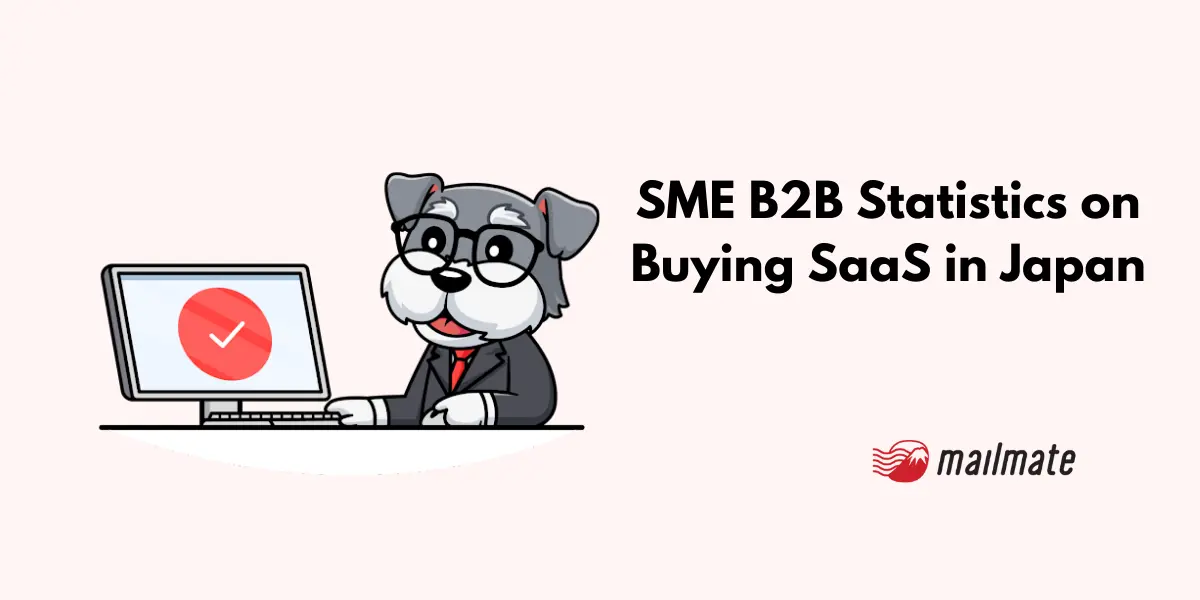SME B2B Statistics on Buying SaaS in Japan

B2B SaaS companies and startups entering Japan’s market may find the dynamics of buyer behavior in Japan hard to crack.
This article looks at statistics from Japanese surveys of SMEs that help to demystify the B2B SaaS purchasing process of companies in Japan.
Company size vs number of selection members
Mazrica, a company that specializes in AI-based sales and customer relationship management software, published the results of an online survey they conducted in May 2022, with a total of 469 participants.
The Japan Sales Report survey targeted companies with over 100 employees who had purchased software that cost over 1 million yen in total or 1 million yen total for 1 year. The report aimed to present the findings of the survey regarding the state of sales in Japan.
Of the participating companies, 28.6% of the companies had between 100 to 500 employees; 35.4% had 500 to 3,000 employees, and 36% had over 3,000 employees.
When respondents were asked whether they had experience in software purchases, 56.4% said they had experience, vs 43.6% who said they did not. Additionally, only 1.5% of respondents noted that they were able to make purchasing decisions by themselves, while 98.5% said they could not.
One of the key findings of Mazrica’s report is that as the size of a company increases, the number of individuals that must be consulted before a purchase also increases. In companies with more than 3,000 employees, more than half have 11 or more members involved in the SaaS selection.
While it seems obvious, it’s worth noting that the data showed as the number of involved parties increases, the purchase timeframe also lengthens. When there are more than 11 selection members, 50% of the companies require a consideration period of more than six months.
Additionally, as the purchase amount goes up, the buyer journey tends to be longer. For purchases of over 100 million yen (668,000 USD), 47% of respondents answered that they require a consideration period of more than one year.
Having a software purchase committee is not singular to Japan. According to the B2B Software Buyer Behavior report from G2, the majority of companies across the globe (80%), rely on a buying committee to make decisions about purchasing software.
Hindrances to the sales process in Japanese companies
Mazrica’s report also revealed that when sales support for the internal approval process is insufficient, the probability of purchase cessation increases by 2.7 times.
The question posed to respondents was “Did you receive support from the sales representative?” Of the respondents who went on to buy software, only 10.1% did not receive support for the internal sales process. Of the respondents who did not buy software, 27.2% did not receive support for the internal sales process.
|
Did Not Receive Support |
Received Support |
Bought Software |
10.1% |
89.9% |
Did Not Buy Software |
27.2% |
72.8% |
Mazrica’s analysis of the data they collected suggests that sales support for purchasers strongly influences the success or failure of purchase activities.
Sales reps need to focus not only on explaining and promoting their company/products but also on understanding the purchaser's approval process and facilitating the internal approval of the sale.
Additionally, respondents were asked about the challenges they faced while considering a software purchase, the overall replies were as follows:
What were the challenges you faced in purchasing software?

Challenge |
Percentage |
Internal approval |
41.8% |
Securing budget |
32.6% |
Consensus among project team members |
29.9% |
Defining selection criteria and requirements for products/services |
21.3% |
Price negotiation |
21.3% |
Sharing necessary information internally for consideration |
15.1% |
Gathering information from inside and outside the company |
14.9% |
Understanding and comparing products/services |
13.6% |
Convincing opposing forces |
8.5% |
None in particular |
7.2% |
When respondents were asked for reasons they decided not to purchase software, the most common reason for discontinuing consideration was budget-related.
What was the reason for discontinuing (postponing) the purchase?

Reason for Discontinuing Purchase |
Percentage |
Budget not obtained |
35.6% |
No suitable service for our company |
30.4% |
Proposal/approval not passed |
19.9% |
Priorities changed |
19.4% |
Budget significantly exceeded |
17.3% |
Decided to do it in-house |
9.9% |
Other interesting points that Mazrica surfaced:
The number of companies that purchasers consider when looking for a software solution is 2-3 products on average.
In larger-scale purchases, the number of software products that buyers consider also tends to increase, but if inquiries are made to more than 6 companies, the probability that the purchase will not be executed also increases.
Information channels during purchase consideration
The Japan Sales Report also highlighted that the most common method of information gathering is through Internet searches and SaaS analytics. High-ranking decision-makers tend to prefer reading-and-thinking type of information gathering, and the importance of channels other than searches increases with the cost of the purchase.
Where do you go to find information regarding a potential purchase?

Information Source |
Percentage |
Internet Search |
60.1% |
Seminars/Webinars |
39.4% |
Exhibitions/Trade Fairs |
33.0% |
Referrals from Acquaintances |
21.7% |
Web Advertisements |
11.1% |
TV Commercials |
10.9% |
Books Magazines |
9.4% |
Newspapers |
7.2% |
SNS |
5.8% |
E-Newsletters |
3.4% |
Advertisements in Taxis/Trains |
3.0% |
Blogs |
2.1% |
Other |
3.8% |
While Mazrica’s report was based on findings drawn from interviewing enterprise companies (with 500 to 3000 employees) a separate purchase behavior report by Medix, a B2B digital marketing firm in 2019 had a respondent pool that included small businesses of under 10 employees at 38% of the total and 11 to 100 employees at 17.8%.
A total of 516 companies throughout Japan participated in the survey, and the survey parameters were companies that had made a software purchase within the last year.
One of the questions to help understand the sources of information for buyers was the following:
Please tell us about the business-oriented media you frequently use during the awareness trigger phase.

Media Source |
Percentage |
Nothing in particular |
39.9% |
Yahoo! News |
33.3% |
Nikkei Digital Edition |
23.8% |
Toyo Keizai Online |
17.6% |
Diamond Online |
17.4% |
Nikkei Business Digital Edition |
14.7% |
SmartNews |
10.9% |
President Online |
10.9% |
Newspicks |
5.2% |
Gunosy |
4.5% |
Others |
1.6% |
Respondents were also asked to list the IT-related media they frequently use during the awareness phase.
Please tell us about the IT-oriented media you frequently use during the selection phase.

Media Source |
Percentage |
Nothing in particular |
62.2% |
IT media |
12.2% |
Nikkei xTECH/Nikkei xTECH Active |
11.8% |
MyNavi News / IT |
7.8% |
Ascii.jp |
6.8% |
IT Trend |
6.6% |
Business + IT |
5.8% |
Keymans Net |
5.4% |
@IT |
5% |
Techtarget Japan |
4.8% |
Cnet Japan |
4.5% |
Cloudwatch |
2.5% |
Shukan BCN+ |
1.7% |
Boxil SaaS |
1.4% |
Other |
0.4% |
What Japanese SaaS buyers want to see on a website
Medix’s survey asked respondents what they’d like to see during the consideration phase of the buyer journey. Here’s how they responded.

Preference |
Percentage |
Features and service outline |
31.8% |
Price |
30.2% |
Case studies |
28.3% |
Latest industry news and trends |
23.4% |
A competitor comparison graph |
20% |
Detailed list of features |
19.8% |
Specifications & Operating Environment |
16.1% |
Failed case studies |
15.7% |
Product demo |
11.2% |
Seminar and event information |
10.9% |
Contract and purchase how-to info |
10.9% |
Industry trends, data and research |
9.9% |
Explanation of terms |
9.5% |
Support information |
8.5% |
Reviews |
8.5% |
FAQ |
5.2% |
News releases |
5.2% |
Other |
0.2% |
Nothing in particular |
24.2% |
The highest preference was for "Features and service outline" at 31.8%, indicating a strong desire for clear and comprehensive product/service descriptions. "Price" and "Case studies" also rank highly, at 30.2% and 28.3% respectively, reflecting the importance of cost considerations and real-world examples.
"Latest industry news and trends" and "Competitor comparison graph" are also significant, at 23.4% and 20.0%.
These preferences provide valuable insights for businesses in understanding what information potential buyers prioritize during their decision-making process.
Key takeaways on SaaS buying behavior in Japan
Here are the key takeaways from the article on SME B2B surveys regarding buying SaaS in Japan:
Larger companies have more members involved in the SaaS selection process.
Companies with over 3,000 employees often have 11 or more members in the decision process.
Longer consideration periods are associated with a higher number of involved parties.
Insufficient sales support during the internal approval process can significantly increase the likelihood of purchase cessation.
Challenges faced in purchasing software include internal approval, budgeting, and consensus among team members.
The most common reason for discontinuing a software purchase is budget-related issues.
The most common method of information gathering is internet searches.
Higher-ranking decision-makers prefer reading and thinking-type information sources.
Use of different channels, like seminars/webinars and exhibitions/trade fairs, increases with the cost of purchase.
Business-oriented media used in the awareness phase include Yahoo! News, Nikkei Digital Edition, and Toyo Keizai Online.
IT-oriented media frequently used include IT media, Nikkei xTECH, and MyNavi News.
High preference for clear and comprehensive features and service outline and price information on vendor websites; case studies are also a high priority, indicating the importance of real-world examples. There is also buyer interest in seeing the latest industry trends as well as a competitor comparison graph.
These insights highlight the importance of understanding the unique buying processes and information preferences of Japanese SMEs when selling SaaS products in this market. The findings underscore the need for tailored sales support, clear product information, and an appreciation of the role of different information channels and content types in influencing purchasing decisions.
Spending too long figuring out your Japanese mail?
Virtual mail + translation services start at 3800 per month. 30-day money-back guarantee.

